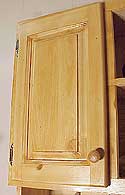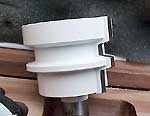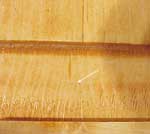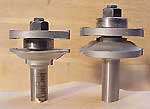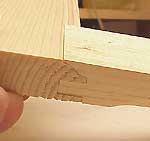This is a Veteran Owned site
 |
|||||||||||
Building Raised Panel DoorsThey are easier to build than you thinkText & Photos by Tom Hintz
Raised panel doors have been around nearly as long as woodworking itself and continue to be a favorite for enhancing a wide range of projects. The look of sophistication and craftsmanship raised panel doors provide is, if my email is any indication, both beautiful to the viewer and intimidating to new woodworkers. The good news is that with patience, practice and a modern router bit set, you can make great looking raised panel doors for your next project. Note: The procedures described here work with most modern router bit sets, but as always, follow the manufacturers directions. Qualifying The MaterialsChecking and matching the thickness of the wood being used to build a door frame and the raised panel can be a big help. If you have a thickness planer available, sizing the lumber is easy. Without such a machine, carefully measuring the wood and then matching the pieces as closely as possible will help. If you have to use wood that is less than consistent in thickness, try to match the presentation side so the heavy sanding can be confined to the rear of doors or panels. Panel Glue-Up
Raised panels are usually large enough to require gluing-up two or more pieces of stock. Because a raised panel "floats" within the frame of the door, there is very little stress on the panel. The strength of modern adhesives means virtually any type of good fitting joint will be strong enough. If you choose to add biscuits or other joint-strengthening techniques, their placement is important. Shaping the panel edges removes a considerable amount of wood, drastically reducing the thickness. If biscuits are located too close to the edge, they can be exposed during the raising process. Some raised panel bit sets include a glue line cutter that carves an interlocking edge in boards being joined to form a panel. The joint created by these cutters is self-aligning, very strong, and is usually so difficult to see that it has little or no effect on the appearance of the panel. The downside is that these bits can be difficult to set up. Read the instructions for aligning the bit, and then use scrap identical in thickness to the wood being glued up for testing the setup. Cut Inside Edges First
Setting up the stile bit, used to form the inside edges of both the rails and stiles, is crucial because it directly affects the appearance and the strength of the door. Most stile bits shape the edge of the rails and stiles, and cut the panel groove at the same time. While some stile bits are adjustable, the height, in relation to the router table surface, significantly affects how deep the pattern is cut, and how close to the rear of the piece the panel groove is cut. Make a few test cuts on material the same thickness as that to be used for the rails and stiles to find the bit depth that produces the look you want without cutting the groove too close to the rear of the wood. When using ¾"-thick material, I like to have a minimum of 3/16" between the panel groove and the rear of the piece. Setting the rail bit depth of cut is where we can cause ourselves lots of problems. If not set correctly, the rails and stiles will not align properly, requiring lots of sanding to smooth the joint. Getting the center panel into a groove that does not match between rails and stiles is all but impossible without modification. I use one of the finished stile pieces, aligning the cutter edges that cut the tenon with the edges of the groove in the stile. Usually, making one or two test cuts in scrap gets this alignment perfect. Since most rail and stile bit sets cut both the rails and stiles with the pieces positioned face down on the router table, the front of the joints remain flush while any difference in stock thickness is only evident on the back of the door. Smoothing a small ridge on the back of a door can be done without affecting the outward appearance. Center PanelThe most common problem noted in the emails I get on raised panels doors is sizing the center panel correctly, followed closely by machining it properly. At least some of these problems are caused by instructions that are clear only to the folks who designed the bits. The easiest way I have found to determine the finished size of the center panel is to measure the depth of the panel groove and the actual opening in the dry-assembled frame. With the frame in clamps and the joints just squeezed together, measure the height and width of the opening, add the groove width (doubled) to those dimensions, and then subtract the amount of clearance desired. For example, if the opening is 10"-wide by 15"-tall and the groove is ½"-deep (1" total), cutting the panel to 10 ¾" by 15 ¾" gives us 1/8" clearance on each side. If spacers that center the panel in the groove are to be used, the overall size of the center panel usually has to be further reduced. Instructions for the spacers should define that amount. Backcutting
Some raised panel bit sets are made with a back cutter that removes material from the back edge of the center panel at the same time it cuts the profile on the front. You can also make this back cut with virtually any flat-bottomed bit. The "back cut" sets the panel back in the frame, reducing how far it projects above the rails and stiles. Panel raising bits without a back cutter remove all of the material from the face of the panel until the edges fit into the grooves in the rails and stiles. This moves the center panel outwards accordingly. By making a back cut first, you can control the amount of the panel protruding above the rails and stiles. When making a back cut, remember that there must be enough material left for the raising bit to cut its full profile without making the edges too thin to fit the grooves properly. Back cuts are not mandatory, but rather an option some use to alter the looks of a raised panel door. Fit and GlueI always assemble each complete door without glue as a final check to be sure there are no binds or other problems to be corrected. Forcing an ill-fitting raised panel door together is a great way to insure its failure in the near future. When satisfied with the fit, apply a thin coat of glue to the rail ends and the corresponding area on the stiles. The fit between the rails and stiles should be very close, meaning the amount of glue needed will be small. Do not apply glue in the panel grooves! Place the assembled door in clamps and apply just enough pressure to squeeze the joints closed. Check to be sure the door is sitting flat in the clamps and that the door is square before letting it dry. FinishingSome like to apply finish to the center panel before assembly, others do all finishing after the door is glued up. Staining the center panel before assembly helps prevent a thin unfinished line appearing if dry weather shrinks the door parts. Building raised panel doors is mostly an exercise in setup and patience. Take your time to get the router bits set up correctly, test fit everything before gluing and you can produce fine looking doors for any kind of project. Making raised panel doors from pine for your shop cabinets is great practice before tackling that oak entertainment center. Visit the Infinity Cutting Tool web site - Click Here Do you have a comment about this page? - Email Me! |
All written, photographic and drawn materials are property of and copyright by NewWoodworker.com LLC 2000-2019. Materials may not be used in any way without the written permission of the owner.

